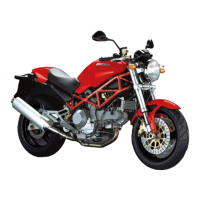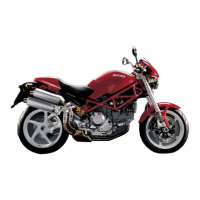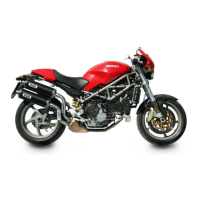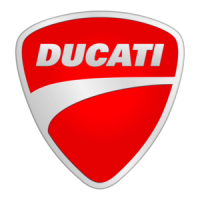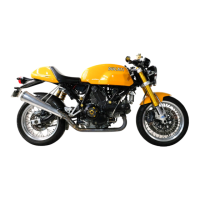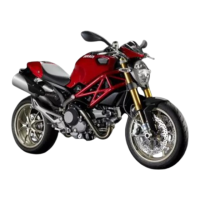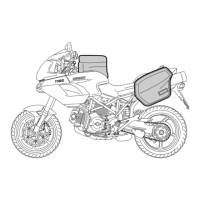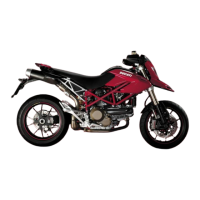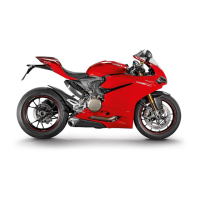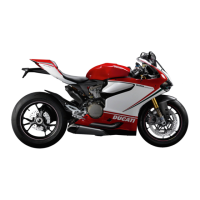Do you have a question about the Ducati SPORT 1000 S and is the answer not in the manual?
Emphasizes crucial safety precautions for riding, including licensing and protective gear.
Alerts users to critical information about controls for safe operation.
Lights up if engine oil pressure drops to a dangerous level.
Electronic system that locks the engine when the ignition is off.
Important notes regarding the red key and its protective sleeve.
Advises on safe storage of keys and the code tag.
Step-by-step guide to disarming the immobilizer using the throttle.
Procedure for obtaining and programming new keys.
Details the four positions of the ignition switch and their functions.
Controls engine run/stop functions, with an emergency use warning.
Explains pedal movements for engaging gears 1 through 6 and neutral.
Using the helmet hook to secure helmets when the motorcycle is parked.
Caution against leaving helmets attached while riding.
Advice on parking surfaces, slopes, and safe sidestand use.
Describes the damper's role in improving steering precision and stability.
Guidelines for the initial 1000 km, including engine speed limits.
Advice on gentle braking for the first 100 km to bed in pads.
Familiarize with controls before starting the engine.
Note that the oil pressure warning light should turn off.
Position the stop switch and press the starter button.
Using both brakes and engine braking for optimal stopping.
Caution against sudden braking to avoid losing control.
Steps to reduce speed, stop, and turn off the engine.
Do not leave the key in ON when the engine is stopped.
Caution about the hot exhaust system after operation.
Danger of using external locks that may impair operation.
Do not overfill; keep fuel below the filler cap recess rim.
Use unleaded fuel with at least 95 octane rating.
Ensuring fluid levels are above MIN marks for system efficiency.
Fluid is harmful to paint/plastic; avoid contact and mixing.
Clutch fluid level rises as plates wear; do not exceed MAX.
Specifies 1.5-2 mm free play for the throttle twistgrip.
Disconnect negative terminal first, then positive.
Charge battery at 1A for 5-10 hours.
Keep battery out of reach of children.
Specifies approximately 27-29 mm chain deflection.
Use special solvents, avoid high-pressure cleaning, and blow dry.
Warning about using non-specific lubricants.
Steps to access and replace headlight bulbs.
Steps to detach lens, remove bulb, and refit.
Steps to detach lens, withdraw assembly, change bulb, and refit.
Steps to loosen screws, remove lens, replace bulb, and refit.
Procedure using a wall to check vertical and horizontal alignment.
Front and rear tyre pressure details (2.2 bar).
Change tyre and inner tube; use original parts; secure valve caps.
Measure tread depth at the most worn point; min 2 mm.
Check oil level via sight glass on clutch cover when cold.
Check spark plugs for condition and engine running indication.
Braking efficiency may drop immediately after washing.
Never grease brake discs; clean with oil-free solvent.
Clean, drain fuel, add oil to cylinders, use paddock stand, remove battery.
List of operations to be performed by an authorized dealer at intervals.
Specifies fuel tank capacity and unleaded fuel requirement.
Details engine type, bore, stroke, displacement, and compression ratio.
States the maximum power output in kW and CV at specific RPM.
Motorcycle is for streets only; avoid unpaved surfaces.
Importance of defensive riding and protective apparel.
Gasoline is flammable; refuel in ventilated area, no smoking.
Exhaust contains CO; do not inhale gases, avoid confined areas.
Details warranty for emission control compliance with EPA/CARB regulations.
Lists items not covered, like tampering, non-genuine parts, competitive use.
| Transmission | 6-speed |
|---|---|
| Rear Brakes | 245 mm disc, 2-piston caliper |
| Engine Type | L-Twin, 2 valves per cylinder |
| Fuel System | Electronic fuel injection |
| Frame | Tubular steel trellis |
| Front Suspension | 43 mm upside-down fork |
| Front Brakes | 2 x 320 mm discs, 4-piston calipers |
| Rear Suspension | Sachs single shock with adjustable preload and rebound damping |
| Fuel Capacity | 15 L (3.9 US gal) |
